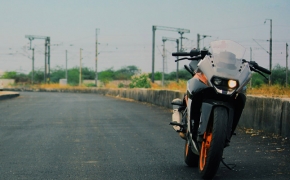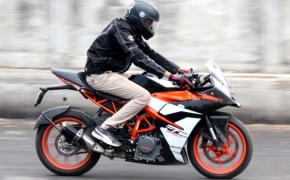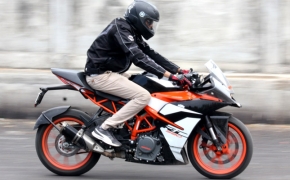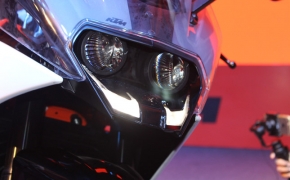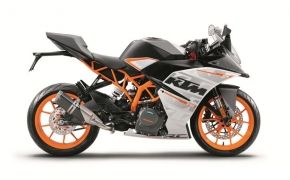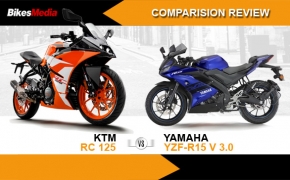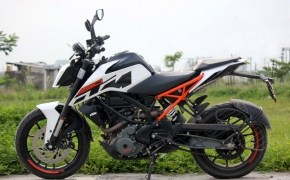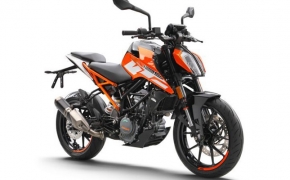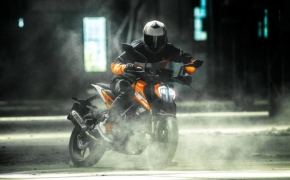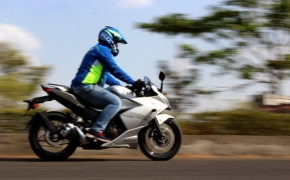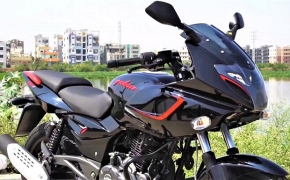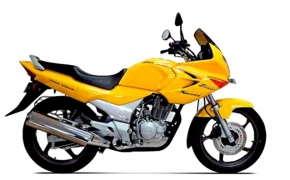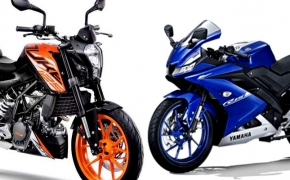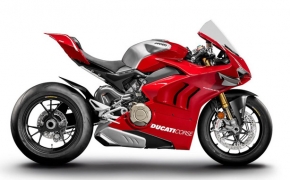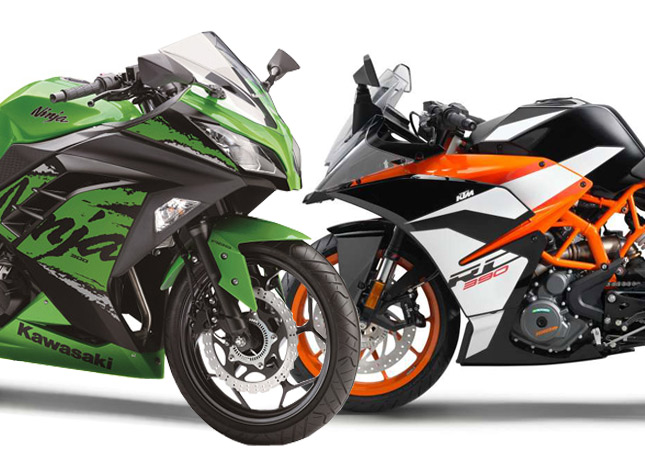 With a massive price cut of almost Rs 62,000, 2019 Kawasaki Ninja 300 has become the most affordable twin-cylinder motorcycle in the country. It still costs around Rs 2.98 lakh (Ex, showroom), as result bikes like KTM RC 390, Duke 390, Yamaha R3 and several others are its main competition. Today we are going to compare the Indian made Ninja 300 with the Indian made Austrian beast, the KTM RC 390. Let’s jump right in.
With a massive price cut of almost Rs 62,000, 2019 Kawasaki Ninja 300 has become the most affordable twin-cylinder motorcycle in the country. It still costs around Rs 2.98 lakh (Ex, showroom), as result bikes like KTM RC 390, Duke 390, Yamaha R3 and several others are its main competition. Today we are going to compare the Indian made Ninja 300 with the Indian made Austrian beast, the KTM RC 390. Let’s jump right in.Engine:
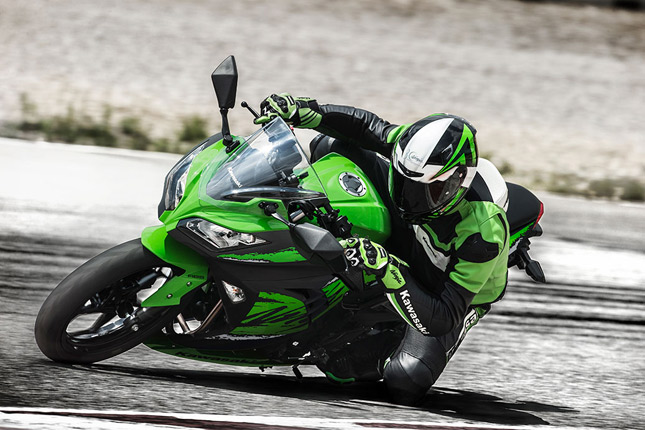 The engine on the Kawasaki Ninja 300 is a 296 cc liquid-cooled parallel twin. It is also used in Versys X 300, which is Kawasaki’s entry-level adventure bike. The engine is in DOHC setup with 4 valves per cylinder and two 32 mm throttle bodies having dual throttle valves. The bore is large at 69 mm while the stroke is tiny at 49 mm.
The engine on the Kawasaki Ninja 300 is a 296 cc liquid-cooled parallel twin. It is also used in Versys X 300, which is Kawasaki’s entry-level adventure bike. The engine is in DOHC setup with 4 valves per cylinder and two 32 mm throttle bodies having dual throttle valves. The bore is large at 69 mm while the stroke is tiny at 49 mm.KTM RC 390’s engine comprises of a single 373 cc liquid-cooled cylinder, which is also shared by its naked cousin, the Duke 390. The engine uses dual overhead cams along with 4 valves. The engine is fuel injected and the throttle is controlled by “Ride by wire” for a precise response. Both, the stroke and the bore are larger at 60 mm and 89 mm receptively.
Power and Torque:
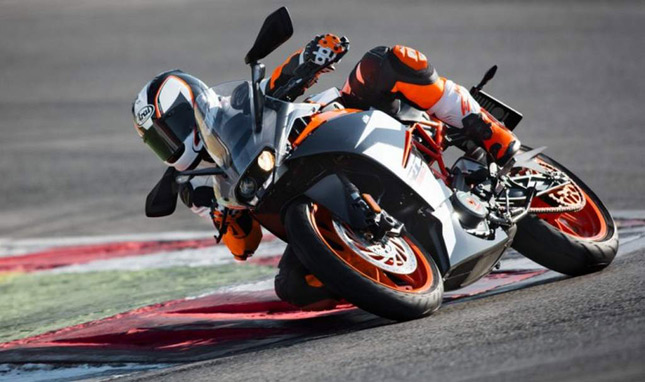 Kawasaki Ninja 300 produces 38.5 BHP @ 11,000 RPM and 27 Nm of torque @ 10,000 RPM. The engine is devoid of any vibrations, as a result, even the 12,000 RPM limit seems nowhere close to breaking point. The downside of this is the lack of a low-end grunt, the torque starts kicking in at 4500 RPM and the power has a very linear and straight climb towards the 10,000 RPM.
Kawasaki Ninja 300 produces 38.5 BHP @ 11,000 RPM and 27 Nm of torque @ 10,000 RPM. The engine is devoid of any vibrations, as a result, even the 12,000 RPM limit seems nowhere close to breaking point. The downside of this is the lack of a low-end grunt, the torque starts kicking in at 4500 RPM and the power has a very linear and straight climb towards the 10,000 RPM. The RC 390 on the other hand makes 43.5 PS of power @ 9000 RPM and 36 NM of torque @ 7000 RPM. The torque band, in this case, is pretty flat and provides the bike with an instant grunt. The top, however, peaks at 9000 RPM as the big single cylinder nears its limit. The top speed of the RC 390 is still devilishly more than Ninja 300 because past 178 km/h, the electronic limiter kicks in and keeps those numbers at bay.
Chassis:
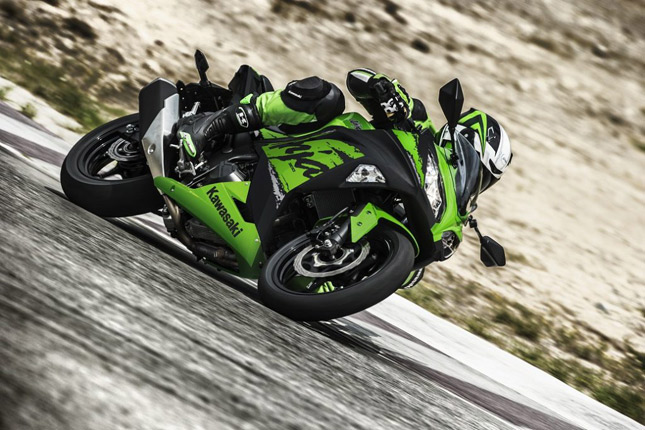 The 2019 Ninja 300 uses a Diamond frame which was pretty standard when the bike was last refreshed. The frame is good for saving weight and offers enough stiffness in the corners. The front 37 mm forks are the right side up and non-adjustable, same can be said for the rear monoshock suspension. At the front, there is a 290 mm petal disc with dual piston caliper and at the rear, we have a 220 mm petal disc with similar dual piston caliper. Wheels are 17 inches at both ends and use a 110/70 mm rubber at the front and a 140/60 tyre at the rear.
The 2019 Ninja 300 uses a Diamond frame which was pretty standard when the bike was last refreshed. The frame is good for saving weight and offers enough stiffness in the corners. The front 37 mm forks are the right side up and non-adjustable, same can be said for the rear monoshock suspension. At the front, there is a 290 mm petal disc with dual piston caliper and at the rear, we have a 220 mm petal disc with similar dual piston caliper. Wheels are 17 inches at both ends and use a 110/70 mm rubber at the front and a 140/60 tyre at the rear.The KTM RC 390 has a trellis frame, which is currently being used in almost every other sports bike. The bike uses upside down 43 mm WP suspension at the front and a single WP monoshock at the rear. The brakes on RC 390 are bigger, with a 320 mm single disc paired with a 4 piston caliper at the front and a 230 mm disc with a single pot caliper at the rear. The bike also features adjustable levers for easy riding. Tyres used in both 17-inch wheels are of 110/70 mm at the front and 150/60 mm at the rear.
Dimensions:
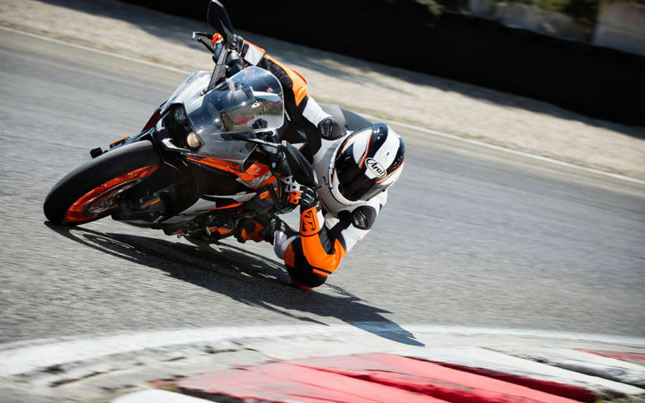 The Ninja 300 has a seat height of 785 mm along with a medium ground clearance of 140 mm. The wheelbase of the bike is 1405 mm while the weight is 179 kg. The 17-litre fuel tank is best in class and will offer at least 400 km on a full range.
The Ninja 300 has a seat height of 785 mm along with a medium ground clearance of 140 mm. The wheelbase of the bike is 1405 mm while the weight is 179 kg. The 17-litre fuel tank is best in class and will offer at least 400 km on a full range. RC 390 on the other side has a tall seat height of 820 mm and an equally big ground clearance of 178.5 mm. The bike has a shorter wheelbase of 1340 mm along with a weight of 170 kg. The downfall of the RC 390 is it’s ultra small fuel tank. With a mileage of 25 km/l, the tank will only give you approximately 237 km of range.
Electrical and rider Aids:
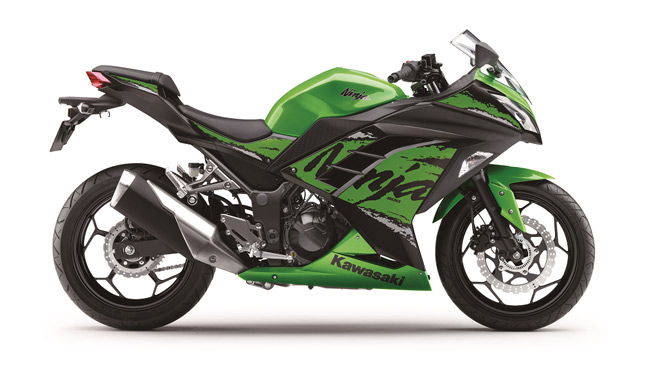 Ninja 300 offers "Assist and slipper clutch" for the lighter clutch pull and no engine breaking during downshifts. The bike also offers a Dual channel ABS and the world’s smallest one at that, for weight saving as well as cost cutting. The dash is pretty standard as a part digital and part analogue one.
Ninja 300 offers "Assist and slipper clutch" for the lighter clutch pull and no engine breaking during downshifts. The bike also offers a Dual channel ABS and the world’s smallest one at that, for weight saving as well as cost cutting. The dash is pretty standard as a part digital and part analogue one. The Ktm RC 390 offers Ride by Wire, Slipper Clutch, Dual Channel ABS and adjustable levers. The console is fully digital and offers every information from speed, fuel to service reminder.
Verdict:
If you consider practicality then Ninja 300 is the clear winner with its easy to ride position, large fuel tank and assist and slipper clutch. However, on a race track, no 300 cc bike can beat the RC 390.
By: Yetnesh Dubey
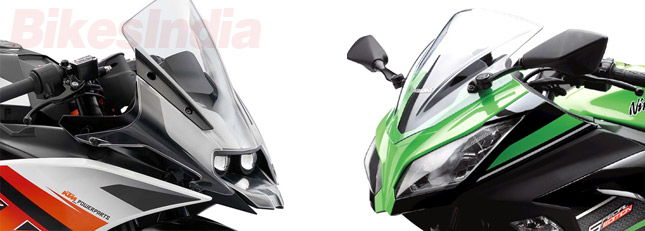 2014 Ktm RC 390 Vs Kawasaki Ninja 300- Comparison
2014 Ktm RC 390 Vs Kawasaki Ninja 300- ComparisonOriginally Posted On: 11 Sep'14
KTM has recently launched RC390 the faired version of Duke 390, the bike shares almost every bit of technical specification with Duke 390 except few small alterations, the RC390 is a one looker and attracts more eye balls on the road. With the launch of this much talked about bike the comparison is inevitable with those bikes available in the same segment and since there is no other bike available in the segment with single cylinder, it is the Kawasaki Ninja 300 having the direct competition with the RC390 despite being twin cylinder. Lets check it out which one has upper hand in this battle of Tech Specs.
Before we move on to the technical jargon lets first look into the different aspects of both RC390 and Ninja 300:
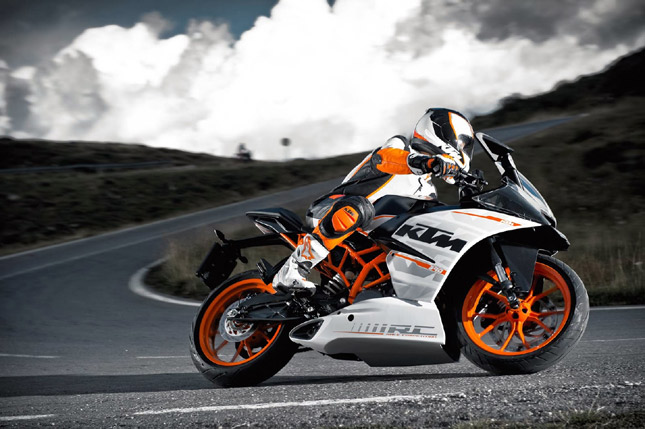 Style:
Style:Both RC390 and Ninja 300 have fairing and both of them are sportbikes but RC390 has more futuristic design than Ninja 300, the RC is featured with stiff Trellis frame which is one of the unique features the bike has in its class. The chassis not only adds the style quotient to the bike but also proves very helpful in making the bike more flick-able and easy to maneuver. The Ninja is on the other hand is also very stylish but somehow looks simple in styling when we compare it with the RC390.
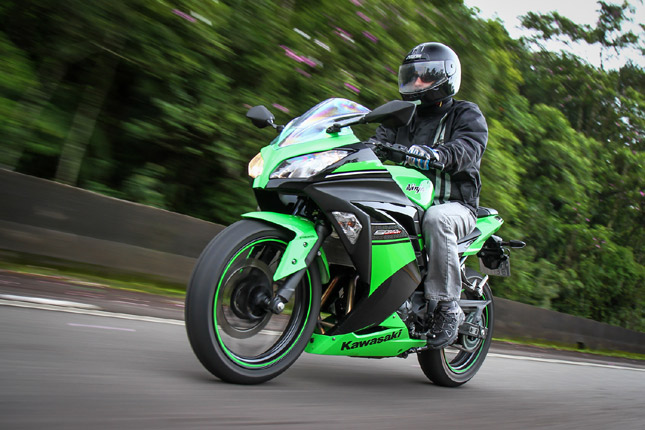 Engine and Performance:
Engine and Performance:As far as Engines are concerned on one hand there is RC390 with 373.2cc single cylinder liquid cooled engine and on the other hand its the Ninja 300 featured with 296cc parallel Twin Engine. Although there is a difference of 77 cubic capacity between both the bikes Ninja with its Twin Cylinder setup managed to get 39 Ps of power at 11000 Rpms and RC tops the chart with 43.5 Ps at 9500 Rpms. If we talk about the refinement of the Engines but natural it is Ninja 300 which has the smoother engine with the twin cylinder setup. The single cylinder engine of RC390 is powerful and to a certain degree refined as well but due to its single cylinder setup the vibrations are inevitable at higher Rpms whereas Ninja 300 has a smoother power delivery throughout the rev range.
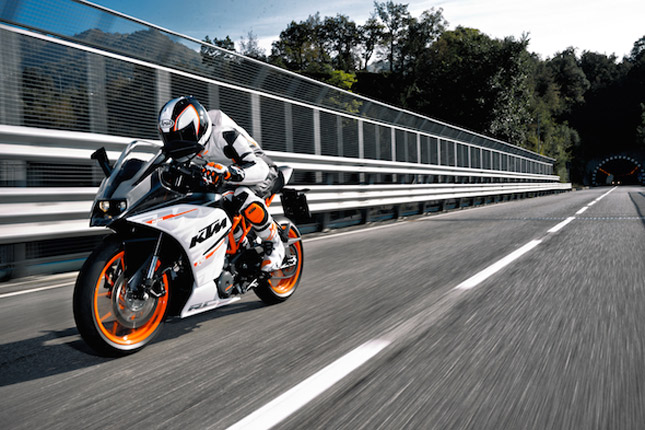 Ergonomics and Comfort:
Ergonomics and Comfort:The RC390 has clip-on handle bars, rear set foot pegs and more compromising crouching position which is apt for racing track, whereas Ninja 300 has more relaxed sitting position and people are already using it for even touring purpose in India. In a nutshell RC is more track oriented bike and riding it for long journeys would be painful and even it would also be uncomfortable riding RC390 in city traffic condition as compare to Ninja 300 which has more upright sitting position.
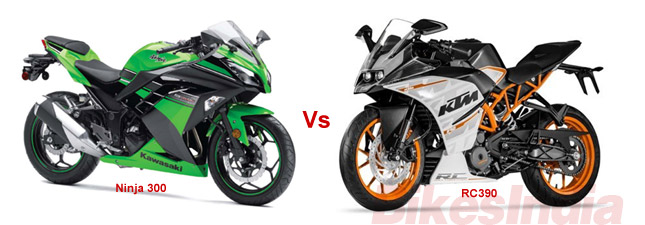 Pricing and Value for money:
Pricing and Value for money:Kawasaki Ninja 300 is a fantastic bike and World over it is known for its reliability and handling but as it is available in India via CKD route it is on the expensive side and now when we are getting RC390 at a price tag of Rs 2.05 Lacs (Ex-showroom, Delhi) the Ninja 300 suddenly starts looking exorbitantly over priced at 3.53 Lacs (Ex-showroom, Delhi). In a price conscious market like ours the difference of Rs 1.5 Lacs can not be ignored and KTM RC390 is going to relish this fact to the maximum extent. Kawasaki had to consider manufacturing their bikes in India to further bring down the prices of their World class Fantabulous products, till then KTM will enjoy the increasing popularity specially in India where they are passing the benefits of local manufacturing directly to the customers.
Detailed Comparative Technical Spec Sheet Of RC390 And Ninja 300
By: Farhan Kashif












